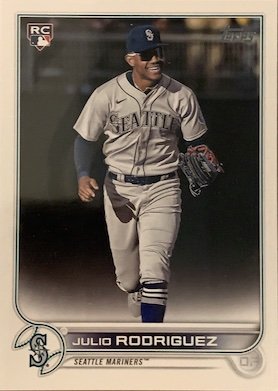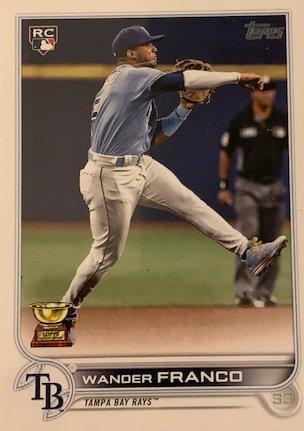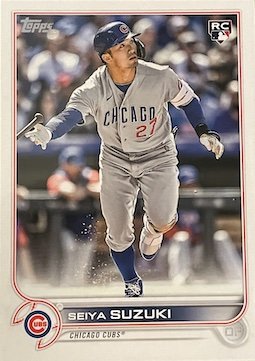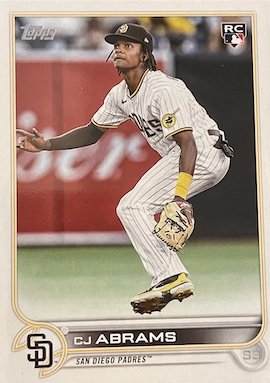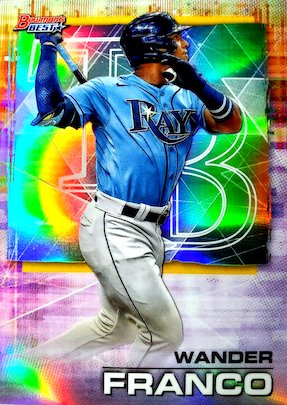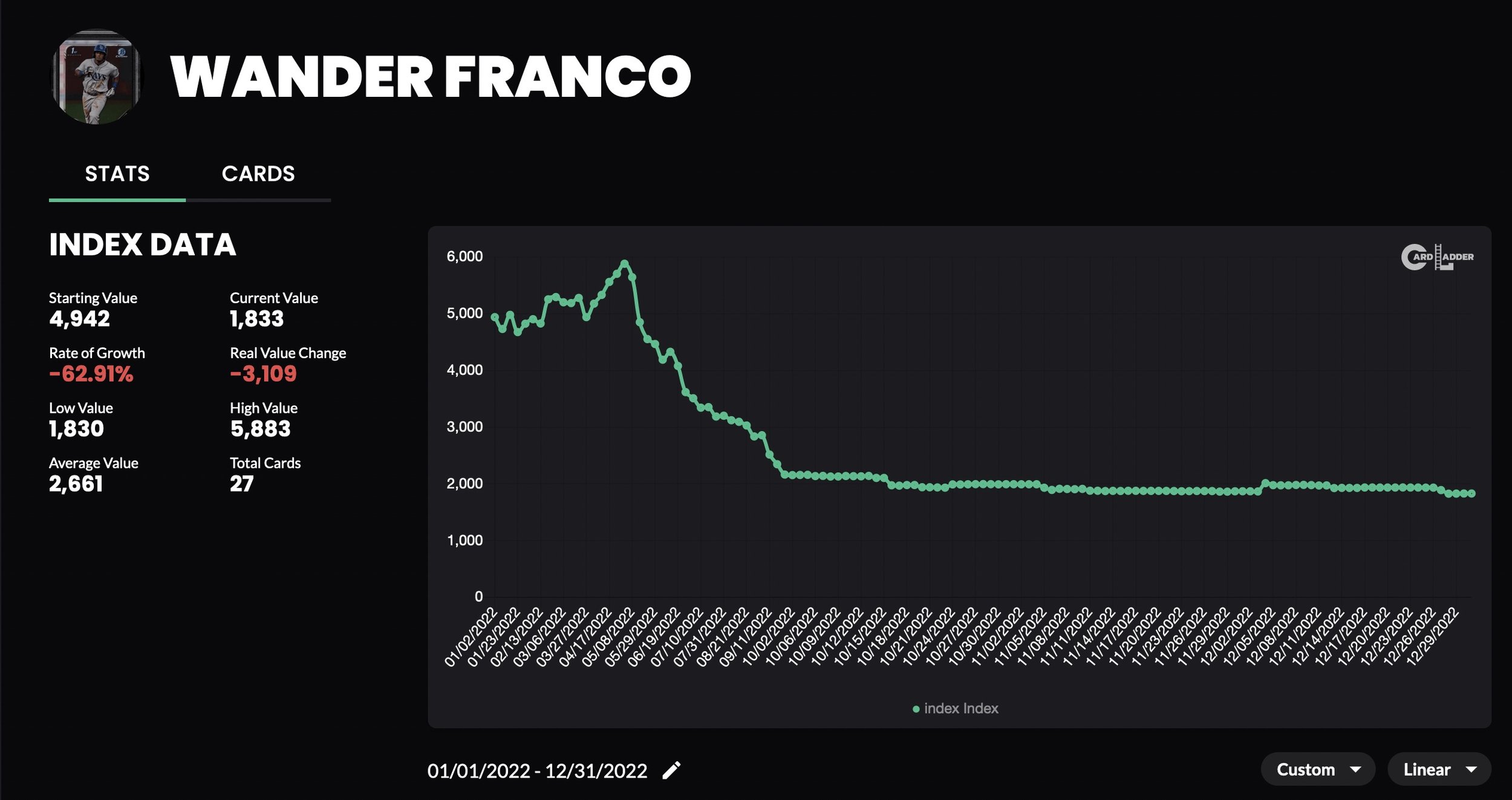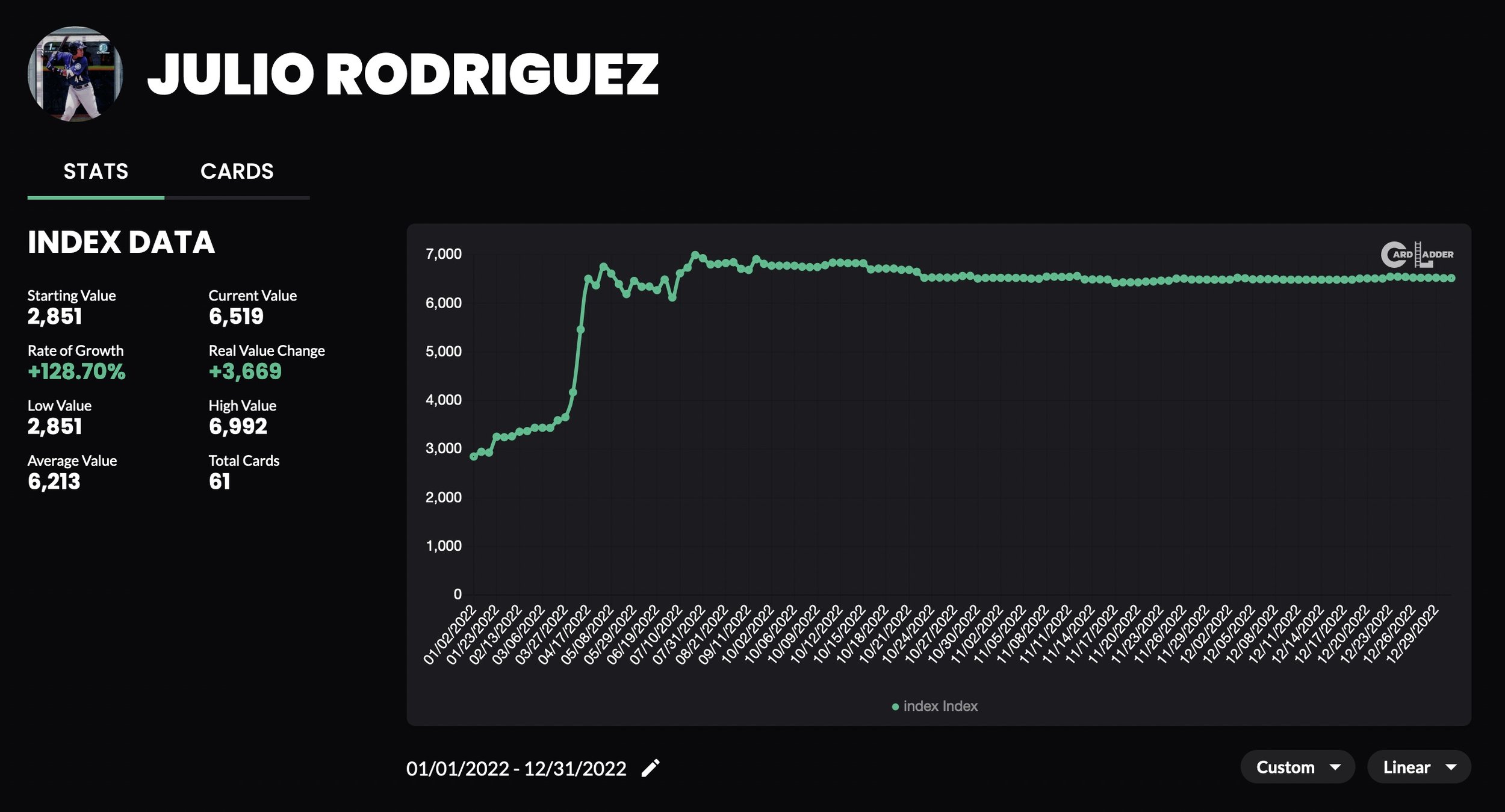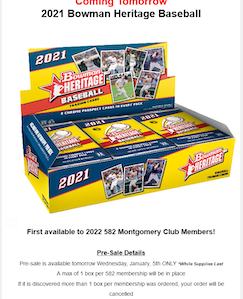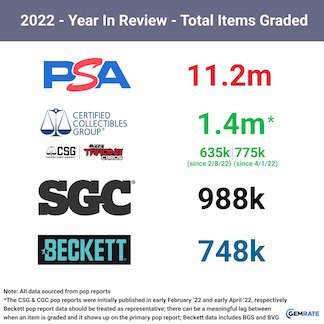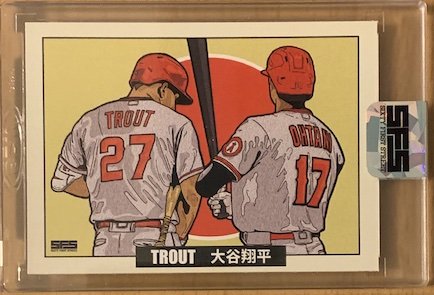As we swim into the uncharted waters of 2023, it’s time for my annual review of the previous year in the baseball card-collecting hobby. I’ll cover what I consider the main themes, some secondary themes, and some of my personal favorites and goals. There’s plenty of good, a whole lot of bad, and way too much ugly.
2022 Rookie Class
After an absolutely demoralizing performance by the 2021 rookie class (as defined within the hobby), the 2022 rookie class falls into that “good” category. I can’t even fathom how bad it would’ve been for the baseball card market if it had been a repeat of the 2021 rookie class disappointment in a market that has come down off of its pandemic highs (more on that later). To recap:
Julio Rodriguez took the league by storm, culminating in bringing home the AL Rookie of the Year award. He hit 28 home runs and stole 25 bases while putting up a 146 wRC+. I think it’s safe to say that there hasn’t been this much buzz around a homegrown rookie in Seattle since Ken Griffey Jr. An absolute superstar and future face of the league.
Bobby Witt Jr. put up a 20/30 season in his debut on a bad Royals team as the focus of all attention on that team. While there can be quibbles about some of his rookie numbers, Witt has the legacy element as a son of a former Major Leaguer and the prospect pedigree of being the second overall pick in the 2019 MLB Draft. The trajectory is there to be a perennial All-Star and face of the franchise.
Jeremy Peña was the true pop-up rookie in this year’s hobby class. The Carlos Correa replacement, no one was questioning that his glove was major league ready. The question was the bat, as he never played above Single-A until 2021 and only had 30 games at Triple-A plus a short stint at the Complex in 2021. And while I still have some questions about his offensive profile, especially with his allergy to walks, it’s hard to deny his ascension to the top of the class given the earned accolades. The first rookie shortstop to earn a gold glove, Peña shined in the Astros playoff run taking home the ALCS MVP and World Series MVP awards. As a rookie - that’s beyond impressive and buys him quite a bit of cachet in the hobby.
A few other rookie class players that either played themselves into the good category or still have enough prospect pedigree to keep product values afloat:
Wander Franco - prospect pedigree for days but injuries and under-performance hurt his status.
Oneil Cruz - prospect pedigree and some highlight reel stuff, but improvements needed with his plate approach.
Hunter Greene - prospect pedigree but started off slow. Triple-digit fastball with big strikeout potential who picked it up to end the season.
Spencer Strider - 130 innings of ace level results with an 80 grade stache - enough said
Cal Raleigh - hit 21 home runs and more importantly has a larger-than-life nickname with Big Dumper.
Steven Kwan - a consummate hitter who didn’t have a swing and miss in his first 116 pitches faced to start the season, the most since 2000. May not have a huge ceiling, but the floor of a really good player is already present.
In addition, there are plenty of others that could still provide some value and interest:
Seiya Suzuki - NPB superstar held back by injury and first time playing in North America led to slightly above average results. Anticipating a lot more to come on a very collectible team with international appeal given his origins.
Juan Yepez - power bat but had to cede a lot of playing time to the Pujols farewell tour. We like power bats in the hobby.
MJ Melendez - positional questions (blocked by Salvy in the short term) and didn’t hit for much average but still hit 18 home runs in his first 129 MLB games after hitting 42 as a minor leaguer in 2021.
Brandon Marsh - showed positive signs of life post-trade in Philadelphia after a miserable stint with the Angels. I am still hopeful he can get close to a .260 20/20 hitter in a stacked Phillies lineup in the future.
There were also some disappointments, but any of these players could further bolster the rookie class:
CJ Abrams - the 21-year-old’s glove may have been ready, but the bat was not. He should get plenty of opportunity to figure it out in the nation’s capital over the next few years.
Spencer Torkelson - underperformed on a bad Tigers team but there is all the potential to be a hobby hero at some point in the future given the 40+ home run power
Royce Lewis - 12 tantalizing games before tearing his ACL again in back-to-back years. Twins fans can’t help but feel cursed with Buxton and now Lewis.
Jarren Duran - looks like this may have been fool’s gold.
Vidal Brujan - see Jarren Duran.
We tend to view 3 or more standout rookies in a baseball product year to be at least a good year if not a great year, depending on the caliber and collectability of those rookies. Not only does being a potentially great player matter, but accolades/awards, hobby friendly stats, team context, personality, and various other x-factors also come into play. The most recent example is the 2018 rookie class with Shohei Ohtani, Ronald Acuña Jr., Juan Soto, and at the time, Gleyber Torres. Even with the fall-off of Torres, the other three have been able to keep 2018 product prices significantly higher than similar products from other years.
2023 Topps Flagship - Adley Rutschman Rookie Card
Finally, I should mention that there were players that didn’t hit the cut-off date to be included in the 2022 Rookie Class for hobby purposes but will generate excitement for the 2023 class, keeping the momentum potentially going. Mainly that’s Adley Rutschman and Michael Harris II (the 2022 NL Rookie of the year), but there are others with potential including Vaughn Grissom, Brett Baty, Nolan Gorman, Christopher Morel, Riley Greene, Vinnie Pasquantino, Nick Pratto, Miguel Vargas, Corbin Carroll, Shea Langeliers, Oswald Peraza, Ezequiel Tovar, Logan O’Hoppe, Francisco Alvarez, Josh Jung, Triston Casas, Garrett Mitchell, Gunnar Henderson, and more.
And you may ask how a 2022 Rookie of the Year could not have a “rookie card” in his debut season, but rather the following year. It’s due to the agreement with card manufacturers and the MLB and MLBPA that defines the cut-off debut date for players to be eligible for a rookie card in the current season. In 2022, this looks to have been smack dab in the middle of May and Harris did not debut until the end of that same month. All of this rookie card qualification talk leads into another major topic of 2022 - the definition of a Rookie Card
2021 Bowman’s Best and What Is a Rookie Card
Why are we discussing a 2021 product in a 2022 year in review? That’s because 2021 Bowman’s Best was essentially released in 2022 with a street date of December 31st, 2021. And the hullabaloo really was part of the 2022 discussion.
The current definition of a rookie card was formalized in 2006 by the MLB and MLBPA. Unfortunately, I was not collecting cards at the time, so retroactively trying to find this information has proven challenging and I am hoping others can chime in with sources. At a bare minimum, the agreement was mentioned in a press release about the new methodology that specified that a player had to have been on an MLB club’s active 25 man roster (now 26 man). As part of a memorandum of understanding between Topps and the MLBPA on the SEC’s website from what looks to be a Topps 2006 filing with the government org, some further definitions are set forth in sections 14 and 15, which basically seem to be defining how prospects cannot be considered for rookie cards. The most pertinent section states “Prospects may be included solely in Bowman brand products, and then only as inserts as opposed to base cards or in such other manner that ensures that such Prospects will not be viewed as rookies” .
The Bowman brand products stipulation is not currently followed (Topps Heritage Minor League, Topps Pro Debut, 2020 Topps Update Series which includes a prospect insert set). In addition, there are prospect-only releases like the ones just mentioned and Bowman Draft where it would require the entire product to be an insert to follow those rules, which is just silly.
I don’t know if there is a newer set of rules defining the rookie card designation between Topps, the MLB, and the MLBPA, but given the above, it feels like there have to have been at least some exceptions or addendums added.
Bowman’s Best is a product that includes prospects, rookies, and vets. In the years prior to the 2021 release, prospects have been included as an insert set determined through a different card design and card numbering - typically TP1, TP2, etc. (Top Prospects being what the abbreviation stands for). And then came 2021 Bowman’s Best, which included 30 prospects that would typically end up in an insert set as part of the 100-card base set numbering (3, 6, 15, etc.) mixed in with the rookies and the vets.
Beckett, as a company that catalogs all trading card releases and tags all of the cards in its database in regard to its attributes (“RC” for rookie cards, “SER” for serial numbered cards, “AU” for autographed cards, etc.), was faced with a decision on how to approach this. I won’t rehash their full article on the topic, but I encourage everyone to check it out here. The main takeaway is that these 30 prospects (Wander Franco, Bobby Witt, Jr., Julio Rodriguez, Jasson Dominguez, Adley Rutschman, Spencer Torkelson, Marcelo Mayer, Jackson Merrill, and more) meet the three tests for whether a card should receive the RC tag in the Beckett database:
It’s a base card
The product includes veterans (unlike Bowman Draft/Topps Pro Debut/Topps Minor League Heritage)
The product has wide distribution - excludes online-only releases (Finest Flashbacks, etc.) and print on demand releases (Topps Now, etc.)
While I agree that it meets the Beckett criteria, one statement that the author of the article, Ryan Cracknell, makes is that “The only difference between these players and other “rookies” in the set like Jonathan India and Jarred Kelenic is a small RC logo.” However, the design is different for the prospect cards than the rookies and vets, even if it’s not strikingly so. I could argue that the design difference meets the 2006 criteria of “or in such a manner that ensures that such prospects will not be viewed as rookies.” Heck, I could argue the lack of the rookie card logo alone could do that, as Ryan himself noted that difference.
For Beckett, they’ve chosen to follow the rules to the letter, which I understand. They’ve specifically stated that intention does not matter. The RC logo doesn’t matter. what matters is that a card meets their defined rules for getting tagged in their database as a “Rookie Card”. If you choose to follow Beckett’s definition of a rookie card, there’s nothing wrong with that. If you choose to have a different standard for rookie cards, perhaps one based on intent and/or what cards (at least for modern cards) have the rookie card logo, there’s also nothing wrong with that.
At the end of the day, you should collect what you love. And that’s a point that is made in the Beckett article and one I completely agree with.
Fanatics
I was hoping that by the end of 2022, I could report back that we’ve seen a lot of changes, especially positive ones, for collectors. Unfortunately, at a macro level, not much has noticeably changed for the consumers of the hobby.
Products are still overpriced and almost uniformly keep rising in price, even for retail products. A Topps Chrome blaster at $35 a box is still really hard to swallow. I think I may have seen one hobby product throughout the year that was less than the previous year on the Topps website, with almost all of them increasing in price year over year.
There have been no material changes to the product portfolio either, and in fact, adding to it with new editions like Topps Chrome Logofractor (and Sonic, whenever that happens), new Hobby configurations for a product like the previous retail-only Topps Chrome Update, and new/returning products like Topps Cosmic Chrome (new) and Topps Pristine (returning).
Product delays, mistakes and quality issues have also continued unabated. The usual centering, surface, edge, and corner issues all popped up in one release or another.
However, the big deal was the 2022 Topps Chrome Extended Base Short Print debacle. 2022 Topps Chrome products, with the exception of the Hobby Lite configuration, did not have the Extended Base Short Prints shown on the checklist didn’t make it into packs/boxes. These were five rookie cards - Julio Rodriguez, Bobby Witt Jr., Spencer Torkelson, CJ Abrams, and Hunter Greene. With them on the checklist, box prices and break prices shot to the moon pre-release as these cards had a potential to be highly valuable. And then after a metric “expletive” ton was opened in the first few days post-release, and none of those cards showed up, the pitchforks started to come out and the product tanked.
Somewhat surprisingly, Topps acknowledged the issue rather than sweeping it under the rug. Anyone who purchased a hobby or jumbo hobby box would receive a “silver pack” either from Topps, the distributor, or their Local Card Shop. Purchasers of retail value/blaster boxes could submit receipts of those purchases online for a monthly raffle to win an Extended Base Short Print. The silver packs typically contained three base chrome cards plus a base chrome refractor. The extended base short prints were packed out in these packs along with some “surprise hits”. I watched about 100 packs opened by a single breaker and saw roughly 3 to 4 of the extended base short print rookies come out, which isn’t a terrible ratio.
The surprises turned out to be what is most likely expired redemptions including 2018 Bowman Luis Robert autographs, 2019 Bowman Vladimir Guerrero autographs, 2012 Topps Chrome Bryce Harper rookie autographs, and more. Which in and of itself provided some drama as there is a question of how long should Topps hold these cards post-expiration in case people do pull them. I’m not sure there is a clear cut consensus on that topic.
At least for the moment, and maybe never, will we know if Topps would have handled the resolution differently than in their pre-Fanatics day. At the very least they put forth a good effort in a tough spot to provide some sort of recompense even if it wasn’t going to please everyone.
Perhaps the biggest change that can be pointed to is the Topps/Fanatics changing relationship with distributors and local card shops. In an expected but still surprising move, Topps cut out one of the main distributors in the trading card industry, GTS Distribution. Rumors of a second distributor being cut at the same time were floating around, but I never saw confirmation of that fact. It’s really just a question of “when” and not “if”. This is big because it in theory lowers the costs and potentially can provide a fairer model for distribution. On the other hand, Fanatics can simply pocket those profits and use the same old direct distribution channels and methods (Topps direct to retailers and LCS’s and the Topps/Fanatics websites for the general public).
Fanatics started to use this playbook with 2022 Topps Diamond Icons in the summer which completely skipped distributors and Topps Direct pre-orders from what I’ve been told. They then followed it up by undercutting retailers and Local Card Shops with some recent hobby releases, most notably with 2022 Topps Stadium Club and 2022 Topps Chrome Update Hobby boxes. They even went so far as to credit back to Topps Direct customers on their Chrome Update Hobby cases due to the backlash with their general public website price rumored to be at least $15-$20 if not more under MSRP communicated to their Direct Account customers.
We did see some one-off instances of improved customer service, for example with a just expired Ohtani rookie auto redemption that Topps customer service did their best to brush aside by attempting to appease the collector with a pitiful replacement package. Once escalated by the collector to Fanatics Customer Service, the Ohtani auto magically appeared and was sent to the collector. That aside, it was essentially more of the same, which, in year 1 of the new owners, is a lot less than many collectors were hoping to see.
The Market
The baseball card market is quite interesting and a lot of it depends on your perspective. I think if you get the anecdotal opinions of collectors, the majority would say that the market is down to one degree or another. More specifically, they probably would say that it’s off from the heights of the pandemic madness.
Card Ladder 2022 Baseball Card Index
Taking a look at the overall Baseball Card Index from Card Ladder, we’re looking at what is essentially a flat market over the last 12 months that had a roughly 15% over starting value peak in May before drifting back down to the flat mark.
Card Ladder 2021-2022 Baseball Card Index
If we continue to zoom out, that perspective I spoke of gets more and more positive. At the two year mark, growth was significant with the market more than doubling. The initial peak was in the spring of Q1 2021, drifted off the highs, and then began a strong climb up again starting in mid-summer of 2021.
Card Ladder 2020-2022 Baseball Card Index
At the three year mark, we can see the market essentially having tripled with a slow steady growth and then the beginning of the rise in the 2020 off-season that we just miss out on in the two year chart.
The conclusion to be drawn from the overall baseball card market perspective is that while it feels like the market has cooled down, the macro level looks pretty good.
Card Ladder 2022 Index for Mickey Mantle Cards
Moving from the overall index to specific players also helps to shed some light. One of the biggest and most recognizable players in card collecting is Mickey Mantle. His trading cards are a true blue chip collectible and his 1952 Topps card is arguably the most desirable card. In August, a mint example graded 9.5 by SGC set the record for a single sports card selling for $12.6M at Heritage Auctions. As you can see by the performance of his overall index of cards, it’s steady Eddie and essentially tracking the overall Baseball Card Index for 2022.
Let’s take a look at two of the biggest prospect names, the “growth stocks”, who had their rookie cards in 2022 - Wander Franco and Julio Rodriguez.
Card Ladder 2022 Index for Wander Franco Cards
Franco was probably THE most sought after prospect card, along with Jasson Dominguez, during the trading card bull market. Goldin sold a 1st Bowman Auto Red Parallel numbered out of five of Wander back in May of 2021 for just short of $200K. He had a strong debut including tying the record of Frank Robinson with the longest consecutive games on-base streak (43 games) for a player 20 years old or younger. However, as mentioned above, injuries impacted his season and his overall stat line ended up being pretty similar to his 2021 numbers. But just as in a growth stock, people buying prospect and rookie cards of current players want to see numbers jump year over year. When they don’t, those stocks and trading cards get punished, as we see in Wander’s 2022 graph. It peaked just as the season was getting underway and crashed hard, showing a negative 63% growth rate.
Card Ladder 2022 Index for Julio Rodriguez Cards
J-Rod, as already discussed, did everything anyone could have hoped for. While his prospect cards were a slightly slower burn than Wander even though their 1st Bowman’s were in the same product, he absolutely ascended to a similar tier as Wander over the last few years. And then he put together a Rookie of the Year campaign showing off a five tool skill set. Accordingly, his card index in 2022 went the rocket ship route, more than doubling with most of that work done in the first half of the baseball season. This is after already doubling in 2021 - proving the “high reward” part of the high risk, high reward phrase to be true.
One final market point to take a look at is the graded base card market. We all anecdotally saw the significant volume of graded base cards flood the market with the market boom. This was cited as one of the reasons behind the grading companies getting so far behind and having to raise prices. A lot of these came from 2020 products, especially Luis Robert, but other rookies in the product year as well contributed including Yordan Alvarez, Bo Bichette, Kyle Lewis, and eventually Randy Arozarena.
Card Ladder 2021-22 Index for Yordan Alvarez Cards
So let’s take a look at the most successful player in this group to date - Yordan Alvarez. He’s put together back-to-back sublime seasons, rising to what I consider elite status in 2022. He had a slash of .306/.406/.613 with 37 home runs and a wRC+ of 185 (second only to Aaron Judge in 2022). So his base Flagship rookie cards, at least in PSA 10 form, should be doing pretty good, right? Taking a look at the last two years, this card went from regularly being a $50 - $70 card to now living in the $20 - $30 range with some sales dropping below $20. This card is easily down 50% or more over the last two years.
2020 Topps Series 1 Yordan Alvarez Base Rookie Card PSA Population (Pop) Report
Is it because Yordan has not played well? Nope. Is it because he isn’t a power bat that the hobby loves? Nope. It’s because a bazillion were printed and about half a bazillion were graded. No matter how good the player is, even their theoretically desirable cards aren’t going to be worth the paper they’re printed on if everyone AND their mother has one. Hyperbole aside, there were over 24,000 of this specific base card graded at PSA alone (other grading companies have probably graded plenty as well), with over 60% achieving that Gem Mint 10 grade (that’s a LOT of 10’s). Any card that has a total population count in the four figures is at risk of having more supply than demand. Any card that has a total population count in the five figures, well, it ends up doing what that graph shows, losing value in bunches.
This example goes to show that it’s not about Yordan. Looking at Yordan’s overall card index, they were basically around the two-year highs in the second half of the baseball season before drifting lower with the off-season market doldrums to sit around 10% off of his prices almost exactly two years ago. Even with a young hitter reaching the top 10% of his outcome, a base graded flagship rookie in gem mint form is barely returning the price of grading, if that. Don’t grade base rookie cards!
Another fad that took hold with the trading card market, and larger economic rise, was fractional ownership. The concept is that there are trading cards, sports memorabilia, art, or anything else you can think of as a tangible “asset” or even not so tangible in the case of NFTs like Bored Apes, are too expensive for the average Joe to own. However, companies like Collectable, Rally, Otis, and others have jumped into this space to make it possible to own a “share” of those most desirable and very expensive collectibles. This isn’t anything new - it’s simply taking the concept of corporate stocks and attempting to apply it to collectibles. It’s also quite a bit different in that you are simply buying a static asset rather than an entity with profits and losses.
All that being said, I’ve stayed away from this area as I personally don’t see the attraction and have been wary of these companies. And at the moment that seems like a good decision. According to MTTrading2 on twitter, 90% of all active listings on Collectable are below their asking price. If I understand correctly, that is roughly $9.5M below the initial public offering combined across all active listings. Not great, Bob.
The trading card market, like most markets, has pockets of strength, steady benchmarks, and places of trouble. Sealed product from Topps has sat on Topps’ website for months on end, and some of these products would typically be wiped out on release day (Bowman Draft, Topps Chrome, etc.).
Selling graded ultra-modern, and even modern and junk wax, base rookie cards for strong profits are definitely gone. The fractional ownership fad appears to be in significant trouble. As always, the blue chips like Mickey Mantle continue to maintain their value. And the high risk, high reward cards (prospects and rookies) have a lot of losers and just a few winners, so you have to choose wisely.
Influencers (and Scammers?)
As much as I do my best to ignore the Influencers and avoid the scammers in the hobby, it’s pretty much impossible to do so if you are online at all. And it’s impossible to do a year in review article without discussing them. Each topic in this section could easily merit full articles on their 2022 exploits, but I will purposely keep it brief for my own sake as I don’t want to give them even more publicity than they already get.
While this isn’t in regard to the baseball card hobby, the hunt for the Lebron James 2020-2021 Panini Flawless Basketball Triple Logoman 1/1 card was all the rage in the first half of 2022. Drake, yes, that Drake of music fame, was one of the major hunters. Back in March of 2022 Drake posted to his Instagram 14 boxes (steel briefcases) of Flawless as the hunt began. Having not hit it, he joined hobby “Influencer” Ken Goldin later that month on Instagram to break 20 cases (40 boxes) of Flawless along with other rare basketball hobby boxes including 1986 Fleer basketball with the Michael Jordan rookie as part of the potential cards in the box, which he hit. But no Lebron Triple Logoman was pulled.
For our next contender, billed as the “Biggest Break of All Time”, we saw a combination of Blez Breaks and Layton Breaks, with Layton being one of the bigger and more well-known breakers in the industry. The break consisted of 25 cases of Flawless (15 regular cases and 10 First Off The Line cases) plus two boxes of Panini One and One Basketball. There were 29 spots at $40K each for a total of $1.16M all in for this mammoth break. Held in Las Vegas, the home of Blez Breaks, it was heavily advertised and sponsored by multiple industry players as well as having PSA on site for any immediate grading needs. Unfortunately, the Vegas sideshow reared its head with two female models in bikini tops hanging out next to the cases. The male-dominated chat was predictably the worst version of itself and halfway through the break the models were gone and Layton, a family-friendly breaker, was posting a mea culpa to social media with Blez being the one responsible for hiring the models. In an industry that needs all the inclusion it can get, this was an unfortunate tally in the “ugly” column in 2022. Less important but still pertinent, the break was pretty rough and the Lebron Triple Logoman was not pulled.
Fast forward to May and Backyard Breaks, a newer player in the breaking space on a meteoric rise exhibiting many of the “bro” influencer characteristics with some already shady decisions bordering on scams, was actively hunting the Lebron triple logoman as well. Their primary breaking platform is Whatnot and Backyard has become one of, if not the biggest breaker there, and in general. In May, Whatnot announced a bounty for the Lebron Triple Logoman. Anyone that sold and pulled the card on their platform would win a Lamborghini, and shortly thereafter, Backyard Breaks pulls the card (shocked face). It eventually made its way to Goldin Auctions and sold for $2.4M and thus ends the tale of the Lebron Triple Logoman, at least for now.
But it does not end the tale of Backyard Breaks. Many of the bigger breakers, like Layton and Backyard, seem to get a disproportionate amount of the biggest hits in the biggest products. However, it’s often explained away as the high volume breakers are obviously going to get a higher volume of the bigger hits, which has a fair amount of validity to it. In the case of Backyard Breaks and the volume of product hits, not just case hits, that they were starting to pull this year, that “high volume” defense started to feel more and more questionable.
In stepped Eric Whiteback, a.k.a. The Collectibles Guru on twitter. He put together a lot of math and odds and made some reasonable assumptions as to how likely it would be to hit just four out of the mountain of product hits that Backyard Breaks were seemingly pulling out of Panini products. Here’s the start of that thread on twitter if you want to read through the topic from A to Z. The summary is that to have pulled the four biggest cards out of 2020-21 Flawless Basketball, 2021-22 Prizm Basketball First Off The Line, and 2021-22 National Treasures Basketball would have required opening $40M worth of product and getting fairly lucky, opening quite a bit less than that and getting astronomically lucky, or getting loaded boxes from an inside source at some point in the supply chain.
I never saw a reasoned response from Backyard Breaks nor a willingness to share data to defend themselves. Since this isn’t a court of law, there is no reason that they have to, but on the other hand, why not share information like that if they indeed do that sort of eye-popping volume. While the cards chosen in his analysis and assumptions made by Eric can be questioned, he is working with imperfect data in a smoky situation where he (and many others) suspect fire.
I tend to lean towards the side of someone in the distribution chain diverting the loaded boxes to Backyard Breaks. I wasn’t fully there until recently when we saw how using the Panini hologram sticker on 2021-2022 Crown Royal hobby boxes could identify which boxes contained highly desirable Kaboom cards. Speculation has been that this information was being spread in a specific discord server run by an individual closely associated with Backyard Breaks (likely as a high dollar spender with Backyard as I’ve seen this same person spend a lot of money at other breakers I frequent). I won’t get into those details since it is even more speculative than this whole section of discussion, but it’s safe to say that it provided additional context around the “loaded boxes” theory, making it much more believable.
The next logical step is to say “Why not break exclusively with Backyard Breaks so I can have a chance at all the big hits?”. Unfortunately, there are lots and lots of rumors and examples where there is a high degree of suspicion about the individuals getting the big hits and getting the desirable teams in their version of randoms, which in the past used a deck of cards hand shuffled and pulled rather than an independent service like random dot org. The rumors essentially speculate that those individuals are hand-picked by Backyard Breaks - friends and whales essentially. Ultimately, with Backyard Breaks, where there is smoke, there really does seem to be fire.
There were so many more topics to be covered in this section, but as I said, it could easily be its own article and I can only hold my nose so much. Logan Paul and the $3.5M fake first edition Pokémon purchase authenticated by Baseball Card Exchange (BBCE) which ended up containing junk wax G.I. Joe cards. Marx Cards, a huge PSA group submitter, going bankrupt and putting a bunch of submitted trading cards in limbo while also exposing Card Collector 2 for not being fully honest about using them rather than being a direct PSA submitter himself. Platinum Card Breaks doing scammy and scummy Platinum Card Breaks things. The 1986 Fleer Basketball box opening at the National authenticated by BBCE with pack replacements that seemed really fishy. Card trimming, fake cards, card patch swapping. 2022 had it all and then some.
Other Themes
2021 Bowman Heritage - while I did mention new products being added, there were a few that did not get released in 2022. Big League baseball looks to have been killed off as a low value product, which honestly isn’t a surprise. But the big one, even if it was actually a 2021 product year release, was 2021 Bowman Heritage and it qualifies here as a topic because of the release date being in 2022. Scheduled to go on pre-sale to Montgomery Club members the first week of January 2022, it was at first delayed a week and then Topps simply went radio silent. A sell sheet, checklist, and sale date all should lead to a product being produced - all of which 2021 Bowman Heritage had, minus the actual produced part.
At the very least, if a product was going to be killed off, you would expect some level of communication from the company, but to this day we’ve had none from Topps. The speculation is that the checklist was put together in a way that mirrored the 2021 Bowman’s Best checklist - prospects mixed in with rookies and vets - and that Topps pulled the product because they didn’t want to continue the debacle around what is and isn’t a “rookie card”. If there were other reasons for pulling the product, the thinking goes that Topps would have no problem being forthcoming with more standard reasoning for pulling the plug - production issues, legal issues (although this may have simply been a vague “litigation ongoing and unable to comment” comment), or any other reason you can conjure up.
But to have to make a statement on the 2021 Bowman’s Best rookie debut, which they have yet to do, as the reason behind 2021 Bowman Heritage disappearance would put them in a very awkward position. If the MLBPA still cares about their rookie rules, which they may, and Topps made an honest mistake with 2021 Bowman’s Best, no harm, no foul. But if they actively repeat the mistake, then it potentially puts them at risk of breach of contract or other serious legal stuff we’d have to ask Paul Lesko (the unofficial hobby lawyer) about.
To avoid that situation and not further cast a shadow on their marketing of 2022 rookie products featuring Wander Franco and other potential big name rookies like Julio Rodriguez, Bobby Witt Jr., Spencer Torkelson, and Adley Rutschman (who was anticipated as a 2022 rookie if he hadn’t gotten hurt), it appears they may have actually mothballed an entire product. Hopefully we find out the inside story on this someday.
2021 Topps Chrome Platinum Anniversary Mega Boxes still for sale on the Topps website
2021 Topps Chrome Platinum Anniversary - At this point, I’m guessing Topps and plenty of people with this product STILL sitting in their inventory 6 months after release, wish it had gone the way of 2021 Bowman Heritage and simply was never produced. Originally marketed by Topps on their sell sheet as coming in the Summer of 2021, it didn’t release until the Summer of 2022.
Another product with no real word from Topps on what actually happened. Delays aren’t great, but at this point, any product releasing on its original street date is the exception rather than the norm. However, a one-year delay feels like we should have at least some public information or mea culpa, and perhaps there was and I completely missed it. Absent that, I can only speculate that there were production/supply issues coupled with getting on-card autos from a list full of retired MLB players that proved challenging.
As of writing, you can still go on the Topps website and find Mega Boxes of this for sale. It is a very unloved product as a whole, and what originally seemed like a great idea has been crushed by a poor rookie class, an unbelievably long delay, and what appears to be a huge print run given the amount of product that has been on sale from Day 1.
data compiled by @GemRate on Twitter
Card Grading prices race to the bottom - As the market caught fire, so did card grading. It was a major theme of my 2021 Hobby Year in Review article. New players joined the fray, everyone ramped up capacity, and prices followed suit. The cheapest submission levels were suspended altogether at PSA and BGS. As we wrap up 2022, a lot of that has reversed - the old reliable players (PSA, BGS, and to a lesser extent SGC) are still the go-to while the new kids on the block are step by step falling behind.
Volume is still high - over 14 million cards at the four biggest graders - and especially at PSA as they are the gold standard, coming in with 11.2 million cards graded. But the submission volume to support each company’s increased capacity is only kept alive by seeing a return of grading prices close to what they were prior to the boom, and we will likely continue to see a race to the bottom on those prices. Let’s just hope this doesn’t lead to a revisiting of grading every base rookie card in existence. ***Note on the CSG/CGC grading volume - a lot of that is driven by the volume in Trading Card Games (Pokémon, etc.). If you take that out, they graded the least amount of cards tracked by Gem Rate.
Panini x Fanatics - rumors got hot and heavy in the late summer after the National Sports Card Convention that Fanatics was working on a deal to purchase the Panini America Inc. division of the Panini Group. All that seemed to be in the way was terms and conditions, but late in the year new rumors popped up that during the due diligence phase, Fanatics decided to walk away from the deal. It will be interesting to see how this plays out moving forward as there will be very little left in the way of trading card licenses in Panini America’s stable once the NBA and NFL license transition to Fanatics around 2025. And by interesting, I mean I wonder how low the price will go before Fanatics finally decides to put the Panini Group out of their misery and take the Panini America division off their hands.
Topps 582 Montgomery Club changes - This is the exclusive and limited membership that Topps sells to give members the ability to purchase select products prior to the general public. Since the pandemic, the Topps 582 Montgomery Club (MC) membership was a ticket to a flippers paradise. Realizing the value of this, Topps had begun charging more and more for the limited membership to the point of a significant increase for 2022. Membership renewals went from $200 to $300 and new memberships went from $300 to $600 for the 2022 version.
Fast forward to the 2023 renewals and Topps looks to be trying to take some of the flipping element out of the equation. Prices for renewals dropped to $149 while new memberships went for $199. Products for pre-release access, the bread and butter of the flipping activity for 582 members, was explicitly stated for the first time, and it was restricted to just six products - 2023 Bowman Chrome Sapphire (Baseball), 2023 Topps Chrome Sapphire (Baseball), 2023 Topps Star Wars Sapphire, 2023 Topps Chrome Bundesliga Sapphire, 2023 Finest Flashbacks Baseball, and 2023 Garbage Pail Kids Sapphire. Topps reserves the right to change this list at their sole discretion at any time (for better or worse). If they stick to this relatively small list, it’s definitely nowhere near the money making opportunity it has been in years past.
Finally Topps has said that it will be enforcing a one account per household rule unless having the express permission of Topps to have more than one. Anyone violating this rule could have their membership cut off. And soon after this announcement, we saw Topps doing just that, which to be honest, was a bit of a surprise.
It will be quite interesting to watch to see how this develops and if Topps sticks to its guns or not on the new approach to the 582 Montgomery Club membership.
NFTs - While NFTs were part of the hobby discussion in 2021, they haven’t even registered as a blip on the radar in 2022. Unless, that is, you want to look at a bigger picture economic discussion where Crypto currency is currently in a swan dive due to the FTX scam and numerous other issues.
Bringing it back to the hobby, Fanatics was not only attempting to become a major player in the physical collectables industry through its acquisition of trading card licenses and the eventual purchase of Topps, they also put a major stake in the ground as the majority shareholder in NFT provider Candy Digital. However, and I’m cheating slightly, just as the calendar flipped to 2023, Fanatics sold its 60% stake in Candy Digital. Michael Rubin, the founder of Fanatics, sent an internal letter to Fanatics staff about this divestiture that included a couple of highly negative comments about the NFT space. Rubin wrote “Over the past year, it has become clear that NFTs are unlikely to be sustainable or profitable as a standalone business.” He added “[this sale is] a favorable outcome for investors, especially in an imploding NFT market that has seen precipitous drops in both transaction volumes and prices for standalone NFTs.”
I think we can easily conclude that the NFT fad, at least in regard to the baseball card collecting hobby, lost any steam it had by the end of 2022 and I doubt we see any measurable interest any time soon.
Personal Takes
Favorite Product
My 2021 choice was 2021 Bowman Chrome because of what appeared to be a strong checklist (it has looked less so as time has gone on) and more importantly the base 1st Bowman cards returned. The lack of 1st Bowman base cards in 2020 seems more like an anomaly as we have yet to see that repeat.
With that look back done, focusing on the 2022 products, my favorite was easily Topps x Lauren Taylor.
About the product - it was an online exclusive and one that came in two waves with Wave 1 released on June 28th and Wave 2 released on July 5th with both selling out relatively quickly. Each box cost $20 and came with 6 cards with one chase card per box (Lava foil, Lauren Taylor base, or Lauren Taylor base auto). Low print run player autos and artist proof cards were sold separately on the Topps website.
Why it’s my favorite - I was unaware of Lauren Taylor’s work prior to Project 70. It was quite impressive and she was easily my second favorite artist in the product to Chuck Styles. If she had started off with some PC players for me, I could easily have seen her being my favorite artist in the project. In reality, by the end, it was more of a 1A and 1B situation. To get a dedicated set for her artistic cards was obviously something I was beyond excited to experience.
Taylor’s art and these cards showcase the player, often in unique and interesting profiles with layers embedded into their portrait contextually specific to each player and their locales. It’s hard to beat a PC player being in the set for my favorite card in this product - I get a Buster Posey card in full catcher gear with World Series Buster hugs and the iconic San Francisco Golden Gate bridge profile embedded in the image. I could go down the checklist and probably cite something I enjoy about each of the 40 base cards plus two Lauren Taylor artist base cards, but that is probably a whole article unto itself. Needless to say, I loved this product and don’t have one negative thing to say about it.
Honorable mentions for products include 2022 Stadium Club (as always), the various 2022 Heritage releases (I’m a big fan of the 1973 throwback design), and 2022 Topps Holiday (reminds me of 2019 Holiday, which is my favorite version of Topps Holiday, since they fully dove into the thematic design, and did so again in 2022).
I would be remiss to not mention what seems like the favorite products of the hobby in 2022, which seem to generally land with one of the following - 2022 Topps Finest Flashbacks (continues to have fans in year 3 of its return), 2022 Topps Brooklyn Collection (very strong checklist and value given the price), 2022 Topps Pristine (new product with some fun stuff even if it’s super gimmicky and a breaker nightmare), and 2022 Topps Chrome Logofractor Edition (new edition of a chrome product is always going to draw attention and it had a decent parallel hit rate at a cheap original price point). There are likely a bunch that I am forgetting, and none of those above were on my list for various reasons, but I totally can see why the hobby was into them.
Favorite Card
Obviously any Lauren Taylor card could qualify here, especially with the Buster Posey card. But for the sake of some variety, I will go with the 2022 Topps Series 1 Home Field Advantage of Buster Posey. I did say “some” variety, but still had to stick to my PC player here.
The Home Field Advantage (HFA) cards literally came out of left field when Series 1 started to hit collectors’ hands. They were not listed on the checklist from Topps. I heard zero whispers about them and while scouring eBay pre-release, I came across a Fernando Tatis Jr. HFA listed on eBay two days prior to the official release date. I immediately tweeted out to Ryan Cracknell of Beckett and Ivan Lovegren to ask if this was real since it was not in the checklist and those two hobby insiders tend to have a lot of info. From there it was game on to see what all of the HFA cards would look like and who would be the subjects.
I will admit that these are essentially rip-offs of Panini Downtown cards. Do I care? No. In this case, imitation is the sincerest form of flattery in my opinion. Downtown cards for baseball are unlicensed, so to get a licensed version of Downtown-style cards with the HFA’s is something I am more than happy to enjoy, even with that imitation aspect.
I got lucky with a PC player, Buster Posey, getting a card in this insert set, along with getting it immediately in Series 1 rather than having to wait for it in Series 2 or Update (each release got 10 base HFA’s along with shorter printed “Legend” versions). The Posey HFA, besides Posey himself in his catcher gear, has all the expected San Francisco iconography. The classic Golden Gate bridge dominating the left of the card, the Transamerica Pyramid anchoring the right side of the card, the old school Cable Car, the Fisherman’s wharf sign, the Bay Area foothills, and the ever-present coastal birds (seagulls or pigeons or both). And the cherry on top is that this card was gifted to me from my friend and podcast co-host Ryan Rygiel a.k.a. RySox5.
Honorable mentions for favorite card include, as previously said, the majority of the Topps x Lauren Taylor cards, the Topps Now Padres Playoff Goose (I like oddball cards, especially when animals are showcased), and the Daniel Kearsey Mike Trout & Shohei Ohtani custom (probably my favorite custom card I saw this year with its simplicity and two of the stars of the game).
Collecting Goals for 2023
Looking back at my 2022 goals, it feels like I lightly hit on some and went hard on others.
I’ve got my eyes on you
Collecting Vintage and post-Junk Wax era stuff did happen, but to a small degree, and it was spread out across multiple sports and non-sports trading cards.
I definitely got into more custom and art cards as evidenced by my Favorite Product of the Year as well as honorable mentions in favorite cards.
Finally I grabbed some more PC cards, some long sought after, even if the main one I wanted eluded me - I will get you at a reasonable price one day 2010 Topps Chrome Wrapper Redemption Buster Posey Rookie Card!
Looking forward to my 2023 goals - definitely more of the same from 2022.
Add to the PC - continue to pick up some of the rarer 2018 J.D. Davis rookie cards and, now that he is on my PC team, buy plenty of Giants J.D. Davis cards. Continue to hunt Buster Posey, Brandon Crawford, Willie McCovey, and Willie Mays cards (with the exception of Crawford, those are all slow, expensive burns).
Continue to slowly fill out the 1960 PSA All-Star set, 1999 Upper Deck Century Legends Epic Signatures Set, and the Topps Seattle Children’s Hospital auto set.
Beyond baseball cards, I will definitely be going after non-sports and oddball cards as I have the past few years, especially in things like Star Wars cards. Also I will continue adding cards showcasing females to help facilitate that connection with my daughter and the hobby. For example, I picked up autos of Alyssa Nakken and Rachel Balkovec in 2022 along with a fair amount of NWSL (National Women’s Soccer League) cards.
Final Thoughts
There were plenty of good things in the Hobby in 2022 - a strong rookie class, the return of cards to the retail shelves, the availability and showcasing of artists and their talents either through manufacturer produced sets or doing it on their own, and some really fun products and cards.
There were plenty of bad things - quality control issues, Fanatics not making a tangible positive impact, the market losing steam (along with the real life economy and taking a big chunk of profit along with it), and overpriced products aplenty.
And unfortunately, there were a fair share of ugly things - hobby drama like the rookie card arguments, manufacturers not having the best interests of collectors (or even local card shops) at heart or even worse not delivering on promised product while pretending like it didn’t even exist, and the influencers and scammers running amok.
There were plenty of other stories, big and small, in the hobby at large. For me, these were the ones that stood out as the highlights (or low-lights) in 2022.



